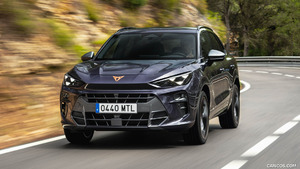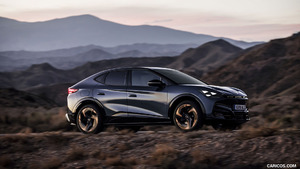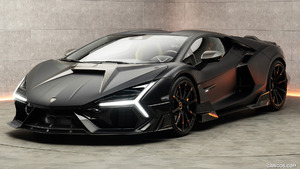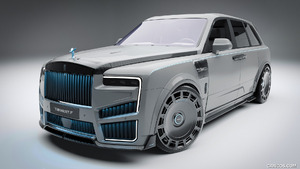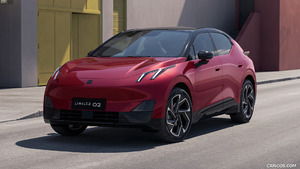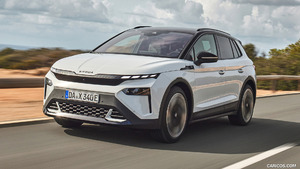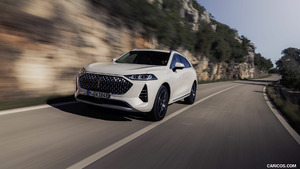2019 Cayenne E-Hybrid (US-Spec)
Added e-performance for the Cayenne
Porsche continues to implement its performance-oriented hybrid powertrain strategy with the Cayenne E-Hybrid. The new model, which is part of the third-generation Cayenne lineup, makes considerable improvements in every area as compared to the predecessor model. Improvements in driving dynamics, performance capability, battery capacity and technology combine to represent the latest development in the progress in electrified Porsche sports cars.
The new model benefits from all of the same improvements as other third-generation Cayenne models including a reduction in curb weight despite increased standard equipment including standard LED lighting, the Sport Chrono Package and Porsche Active Suspension Management (PASM) dampers. Like its non-hybrid siblings, the new Cayenne E-Hybrid now features staggered wheel and tire sizes for sportier driving characteristics, standard Porsche Traction Management (PTM) all-wheel drive and 4D Chassis Control. All Cayenne E-Hybrid models come with a standard onboard 3.6 kW charger, though a 7.2 kW charger is optionally available to reduce charging times where sufficient current is available.
Pricing for the Porsche Cayenne E-Hybrid starts at $79,900 excluding a $1,250 delivery, processing and handling fee. The new model is expected in U.S. showrooms in late summer, 2019. EPA estimates for fuel consumption and electric range are still pending.
Performance
455 hp total system output with 918 Spyder boost concept
Porsche began pioneering electrification in the luxury SUV segment back in 2010 with the Cayenne S Hybrid. In 2014, the Cayenne S E-Hybrid was another groundbreaker, with the introduction of plug-in hybrid technology. The next stage in the journey towards e-mobility is the new Cayenne E-Hybrid. While the performance of the combustion engine generates 335 hp (250 kW) marking a moderate improvement over the supercharged V6 in the preceding model, the electric motor generates over 43 percent more power than the motor in the previous generation. They combine to produce a total output of 455 hp (340 kw) and 516 lb-ft of peak torque just above idle, marking increased in both horsepower and torque as compared to the preceding model. The battery capacity also increases by about 30 percent to 14.1 kWh without increasing in size relative to battery in the preceding model. As in the hybrid Panamera models, the boost strategy matches that of the 918 Spyder super sports car. The plug-in hybrid powertrain enables acceleration from 0 to 60 mph in 4.7 seconds and a top track speed of 157 mph. EPA fuel consumption and electric range figures have not been announced at this time.
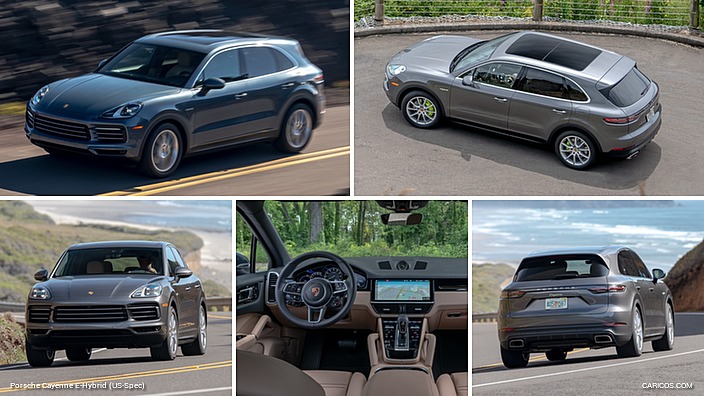 2019 Porsche Cayenne E-Hybrid (US-Spec)
2019 Porsche Cayenne E-Hybrid (US-Spec)
Drive Modes
Choices to suit many needs and scenarios
The new Cayenne E-Hybrid has a range of different driving modes at its disposal. Performance is the primary focus behind implementing a hybrid powertrain in the Cayenne model line, a fact highlighted by the standard Sport Chrono Package. Using the drive mode dial, the driver can toggle between the four modes: E-Power, Hybrid Auto, Sport and Sport Plus. Pressing the Sport Response Button in the middle of the mode switch temporarily adjusts all variable aspects of the vehicle to their most performance-focused setting for 20 seconds. E-Hold and E-Charge modes are also available. These are available via the “Hybrid” menu screen in the 12.3” Porsche Communication Management (PCM) screen. It is also possible to activate the driver-configurable “Individual” driving mode using a dedicated capacitive switch on the center console.
Sport and Sport Plus Modes: Hybrid powertrain to enhance performance
The extent to which the electric motor boosts performance or the battery recharges depends on the driving mode. In the performance-focused Sport and Sport Plus modes, virtually all of the battery's energy can be used for a boost. In Sport mode, the battery is charged just as much as is required for a new boost. In Sport Plus mode, the battery is recharged as quickly as possible. In the other modes, a limited amount of energy is available for boosting in order to support efficient driving. This enables more frequent electric powertrain assistance over a greater period than the preceding model offered. In both modes, the combustion engine remains in operation. In Sport Plus mode, the Cayenne E-Hybrid is able to reach its top track speed of 157 mph.
E-Power Mode: fully electric driving
The Cayenne E-Hybrid always starts in E-Power mode. This prioritizes the electric driving experience. Accordingly, the electric motor and entire high voltage system provide the maximum performance of 134 hp (100 kW) and 295 lb-ft. The driver can adjust the interplay between the electric and combustion engines using a pressure point in the accelerator pedal produced by the control system. Up until this pressure point, the SUV runs purely on electricity. When the driver deliberately surpasses the pressure point, the combustion engine kicks in and provides access to the system’s full drive potential.
In E-Power mode, an “E-Launch” function is available when the battery has sufficient charge: if the brake is pressed when stationary and the accelerator is held at the pressure point at the same time, the Cayenne E-Hybrid starts when the brake is released with maximum, electric-only acceleration. To allow the driver to monitor this function, the electronic instrument cluster displays its activation. In the electric-only E-Power mode, the new Cayenne E-Hybrid can reach a maximum speed of 83 mph. If the battery charge status is below the minimum required for EPower mode, the car automatically switches to Hybrid Auto mode.
Hybrid Auto mode: a dynamic mixture
The new smart Hybrid Auto mode enables the most efficient operation of the Cayenne E-Hybrid in city and intercity traffic. For the ideal combination of electric motor and combustion engine, the drive control calculates the optimum operating strategy based on driving profile, charge status, topography and speed information. Depending on these conditions, the system selects electriconly driving for situations where it makes most sense in terms of overall efficiency. If there is a destination programmed into the navigation system and the vehicle is equipped with Porsche InnoDrive, the system considers the distance in determining when to implement electric assistance.
E-Hold and E-Charge: the driver decides
The driver can manually set the hybrid drive's operating mode using the PCM’s Hybrid menu. There, the E-Hold and E-Charge functions may be selected directly as an alternative to Hybrid Auto mode. While the Hybrid Auto mode strives for the most efficient electric driving to minimize consumption, E-Hold mode deliberately maintains the current state of charge in the battery so that the energy is available at a later stage for electric driving or boosting. By shifting the load point, the driver is able to increase the electric range in advance in order to use it in a specific way at a later stage, for example, in an urban environment. In the E-Charge mode, the combustion engine actively charges the battery.
Powertrain and Chassis
New hybrid model for high power density and responsiveness
The Cayenne E-Hybrid is a parallel hybrid, meaning the electric motor and combustion engine both directly propel the vehicle. A new mono-turbo 3.0-liter V6 works with a permanent-magnet synchronous motor. Based on the Porsche 918 Spyder, the electric motor has been converted from an internal rotor to an external rotor architecture. The idle, fluid-cooled stator is therefore encircled by the moving rotor. The new hybrid module consists of a highly-integrated combination of an electric motor and a separating clutch that operates more quickly than the design of the previous generation.
New battery with 30 percent more capacity
The battery at work in the Cayenne E-Hybrid stores about 30 percent more energy than the battery in the previous Cayenne S E-Hybrid model. Despite that, it is the same size and weight. The fluid-cooled battery is stored beneath the loading floor in the rear of the car and consists of eight modules with 13 prismatic lithium ion cells each. The cell anodes are optimized for high currents during boosting and recuperation. At the same time, the cell capacity was increased by an optimized cell structure and an improvement in-cell chemistry on the previous model, from 24 Ah to 37 Ah.
The plug-in charging system includes a new connection that is even easier to use. The charging key module shows the current status via an LED and allows the driver to switch between timed and immediate charging at the touch of a button. The timer can be programmed for time-shifted charging via the PCM or the Porsche Connect app. In similar fashion, the driver may choose to precondition the climate control settings in anticipation of the next drive. If the vehicle is equipped with the corresponding features, it is also possible to pre-heat the steering wheel and precondition the seats with either warmth or cooling. A specific charging strategy avoids deep discharge, guaranteeing a long lifespan. This means that the car can still be started electrically after it has been stationary for long periods.
Charging times themselves vary depending on the on-board charger and electricity source. The fastest way for energy to pass through is with a high-voltage connection in combination with the optional 7.2 kW on-board charger. A 3.6 kW on-board charger is fitted as standard.
New eight-speed Tiptronic S and controlled Porsche Traction Management (PTM)
The new eight-speed Tiptronic S transmission, developed for the entire Cayenne range offers improvements in shift speed and smoothness. Interruption of tractive force during the shifting processes is also reduced compared to the previous generation Cayenne.
The Cayenne E-Hybrid has an active hang-on all-wheel drive system with an electronically regulated, map-controlled multiplate clutch. With its broad range of torque distribution, Porsche Traction Management (PTM) offers clear benefits in terms of driving dynamics, agility, traction control and off-road capabilities.
Chassis and brakes with all Cayenne options
With a brand new chassis, the Cayenne E-Hybrid offers the same sports car driving dynamics as all other models of the new Cayenne generation. Porsche Active Suspension Management (PASM) is standard equipment. For the first time, a hybrid Cayenne model is also available with optional Porsche Dynamic Chassis Control (PDCC) and rear axle steering. At speeds of up to approximately 49 mph, the axles steer in opposite directions. This feature improves vehicle agility and makes maneuvering easier. For example, rear-axle steering reduces the turning radius from 39.7 feet to 37.8 feet. At higher speeds, both axles steer in the same direction, improving stability at high speeds. The maximum steering angle used on the rear axle is three degrees. Additionally, the new Cayenne E-Hybrid is available with an optional trailer hitch to tow up to 7,716 lbs. The Cayenne E-Hybrid is fitted with standard cast iron brake rotors. In keeping with the Porschetypical brake caliper color scheme, the brake calipers are acid green, but are also available in black. Porsche Ceramic Composite Brakes (PCCB) are also available with calipers in acid green or optionally in yellow.
Interior and Technology
New hybrid-specific display and control design
The Cayenne E-Hybrid’s display is completely reworked and is broadly similar to that of the 918 Spyder. The most noteworthy feature is the standard Sport Chrono Package mode switch, which allows the driver to select different modes directly on the steering wheel. Even the hybrid-specific displays on the electronic instrument cluster are based on those of the 918 Spyder from a functionality perspective. The central Power Meter provides information on energy consumption or recuperation, while the Boost Assistant gives details of the available electrical energy for boosting. The Hybrid assistant helps visualize the point at which the combustion engine kicks in and shows the remaining electric range calculated. The new PCM’s 12.3-inch touch display shows current energy flow, consumption values, remaining electric range and emissions-free driving sections.
Standard independent climate control: heating and cooling with pre-selection
Independent climate control is now standard as compared to the previous generation where it was optionally available. This allows the interior of the car to be heated or cooled before driving without starting the engine. Similarly, it is possible to defrost the windows in cold weather ahead of time. Both functions can be managed or programmed via the PCM or the Porsche Connect app. Furthermore, the optional four-zone automatic climate control system is now available for the first time for the Cayenne E-Hybrid. Rear seat ventilation is also optionally available. More comfort: independent heating, massage seats, load compartment management The expanded range of features for the Cayenne now includes a heated windshield and a massage function for the optional 14-way front seats. Drivers and passengers can choose between five massage programs performed by ten pneumatic massage pads in the seat backs. The new load compartment management also includes two attachment rails integrated into the load compartment floor, a telescopic rod, lashing eyes and a luggage area partition net.
New wheels, Sport Exhaust and Sport Design Package
For sports-focused Cayenne drivers, Porsche is expanding its range of options to include new wheel designs – the 21-inch Cayenne Exclusive Design wheel and the 22-inch Cayenne Sport Classic wheel. The new 21-inch Cayenne E-Hybrid Design wheel is available exclusively for the Cayenne E-Hybrid.
The new sport exhaust system creates dynamics you can experience acoustically. It generates an especially powerful sound experience in the Sport and Sport Plus modes in particular. The high-gloss double sport exhaust pipes in the exhaust system are available in silver or black. The Sport Design Package gives the new Cayenne models an even more sporty look. The standalone components in exterior color ensure an even more unique appearance.
Expanded functions: Porsche Connect and Porsche Charging Service
Porsche Connect offers the customer a range of options to help them connect more with their Porsche. It can be used, for example, to view car information remotely and to control selected functions via the app too. The Porsche Connect app displays the electric-only and the overall range, the battery’s current charge status, and the remaining charging time. It can even be used to operate the independent climate control, i.e. the heating and cooling of the car when the ignition is switched off. Charging stations can be found, filtered and set as a navigation destination.
InnoDrive: an electronic copilot
Porsche InnoDrive including adaptive cruise control, is exceptionally future-forward: the optimum acceleration and deceleration values are calculated for the next 1.8 miles using navigation data and activated via the engine, the Tiptronic S and the brake system. As part of this process, the electronic copilot takes into account curves, inclines and speed limits automatically. Current traffic conditions can be captured by a radar and video sensor and arrangements are adapted accordingly.
The system even recognizes roundabouts and adapts the speed to existing conditions. When Sport mode is activated, InnoDrive also switches into a more dynamic approach. The integrated adaptive cruise control helps the radar and video sensor record the distance from the cars in front and adapts it on an ongoing basis. Active lane keeping permits assisted driving on well-developed roads and motor ways (in a speed range of zero to 80 mph). The system drives the car with light steering interventions and follows the line of cars ahead within system limits. It bases its approach on road markings and other cars on the road.
Function package: Remote Park Assist for independent parking
With the new Remote Park Assist, Porsche has put together a comprehensive optional package of comfort and convenience functions that will be available for the new Cayenne generation in the next expansion phase. The driver cannot only leave parking to the SUV, but also gets help in maneuvering the vehicle and is warned of hazard situations when disembarking and leaving the parking space.
Active parking assistance makes parking much easier. Using ultrasound and camera systems, the system automatically recognizes parking spaces and measures their size. Once the system has signaled that the space is big enough, the driver can press and hold the button on the central console to begin and control the parking process. The system takes over the steering and chooses the speed itself and controls the accelerator and brake automatically. All the driver needs to do is monitor the process. The active parking assistance is able to park the car in horizontal and diagonal parking spaces.
Park Pilot goes a step further, allowing the driver to bring the car in and out of parking spaces via remote control using a smartphone. Once the system has identified a suitable parking space, the driver can initiate parking by pressing the relevant PCM button before disembarking. The parking process is then continued by continuing to press the button on the smartphone app. The garage pilot works according to the same principle and is used when the car is being parked or brought out of a narrow garage without requiring the driver to stay inside the car. Once the Cayenne reaches its endpoint, the engine and ignition are automatically switched off and the car is locked. The garage pilot can also bring the car out of parking spaces. To make this happen, the driver starts the SUV with the smartphone app and lets it emerge for long enough until he can climb in comfortably. 3D Surround View display creates a comprehensive overview The system also helps drivers maneuver by themselves. Remote Park Assist's 3D Surround View display calculates a 360° view using four individual cameras to help with entering and leaving parking spaces and maneuvering the car. One of the system’s major innovations is the perspective-based, three-dimensional display. The maneuvering assistant with its curb alert helps prevent collisions in narrow maneuvering situations where visibility is poor. The function is triggered automatically at speeds up to 6 mph and displays the parking situation in 3D on the PCM’s touch display. If there is a risk of a collision, there is a warning display on the PCM and, where necessary, a steering boost.
Trailer maneuver assistance steers car itself when towing
If the Cayenne is being used for towing, the trailer maneuver assistance makes reverse parking much easier. Once the function is activated, all the driver needs to do is simply put the vehicle in reverse and accelerate gently. They can use the PCM’s rotary adjuster to continually adjust the angle they would like to place the car in themselves. The image from the reverse camera on the PCM provides appropriate guide lines for orientation. The system activates the steering wheel itself and steers the trailer on the course selected by the driver.
Warning functions when disembarking and exiting a parking space
There are also two warning functions meant to enhance leaving a parking space. The first warns vehicle occupants against opening a door when a car is approaching from the rear. In that case, LEDs in the interior door handles flash red. This warning system remains active for three minutes after the ignition switch is turned off. The second function warns the driver if other cars are approaching while pulling out of a parking space where the view of approaching traffic may be obstructed. The warning system includes a visual alert on the PCM display, an audible warning and, where necessary, brake pulsations.






